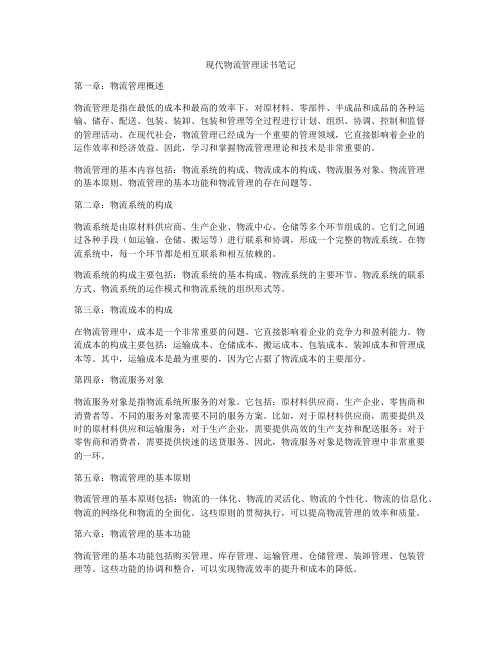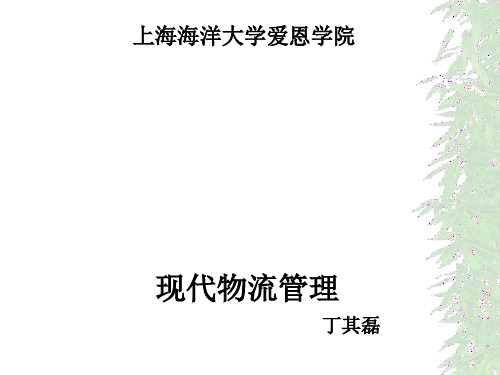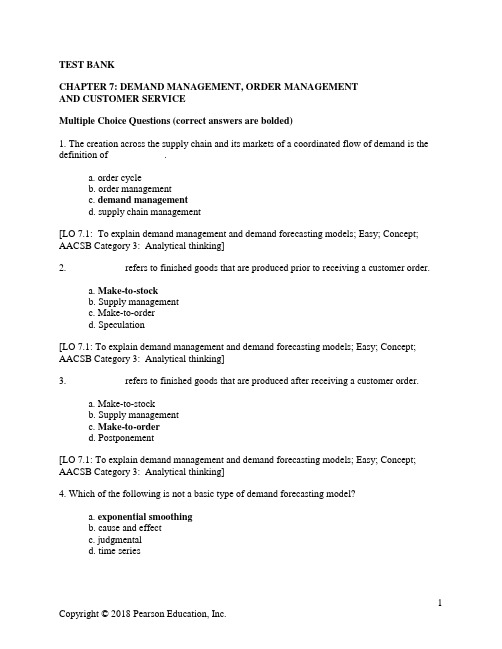第七章现代物流企业服务管理
现代物流概论第七章-物流标准化

监督评价
对标准的实施情况进行监督和评价,及时发现问 题并进行改进和优化。
04
我国物流标准化的发展现 状与问题
我国物流标准化的发展现状
01
物流标准体系逐步完善
我国已经建立了较为完善的物流标准体系,涵盖了基础标准、设施标准、
技术标准和管理标准等方面。
02 03
物流标准化工作取得积极进展
我国在物流标准化方面取得了一系列积极进展,如制定了一系列国家标 准和行业标准,推广了托盘、集装箱等标准化装载器具,提高了物流效 率。
度和忠诚度。
保障安全
通过制定和实施安全标准,可 以保障物流活动的安全和稳定
,减少安全事故的发生。
02
物流标准化的内容与分类
物流基础标准
物流基础标准是指对物流领域的基本概念、术语、符号等进行统一规定,为物流 行业提供一个共同遵循的准则。
物流基础标准包括物流术语、物流符号、物流计量单位等,有助于提高物流行业 的沟通效率和信息传递准确性。
物流设施与设备标准包括仓库、配送中心、集装箱等设施 的尺寸和设计规范,以及托盘、货架、叉车等设备的性能 和接口规范。
物流作业与服务标准
物流作业与服务标准是指对物流作业 流程、服务质量和安全等方面进行统 一规定,以提高物流作业的效率和客 户满意度。
物流作业与服务标准包括运输、仓储、 配送等作业流程的标准,以及服务质 量标准和安全标准等。
物联网技术的发展
随着物联网技术的不断发展,物流信息的实时采集和共享将成为 可能,进一步推动物流标准的统一和优化。
绿色物流标准的制定和实施
面对全球环境问题,未来将更加重视绿色物流标准的制定和实施, 推动物流行业的可持续发展。
智能化物流标准的推广
现代物流管理

二经济订货批量模型;是指通过费用分析求得在 库存总费用为最小时的每次订购批量;用以解 决独立需求货物的库存控制问题
EOQ库存控制模型中的费用主要包括; 1 储存费 2 订货费 3 缺货费
EOQ=
2DC K
2DC
= FP
三零库存
1 零库存的含义
零库存是指在确保企业生产经营活动顺利进 行的条件下;采用各种科学的管理方法;对库存 进行合理的计算和有效控制;尽可能降低库存 量的一种方法
6轮动方式;也称同步方式 是指对系统进行周密设计 的前提下;使各个环节完全协调;从而根本取消甚至 是工位之间暂时停滞的一种零库存 零储备形式
7水龙头方式;是一种像拧开自来水管的水龙 头就可以取水而无须自己保有库存的零库存 形式
8无库存储备;是仍然保持库存;但不采取库存 形式;以此达到零库存
9配送方式
四货物出库制度
出库应遵循以下原则:先进先出;包装不完 好者先出;近期失效者先出;已损坏者不出
五 仓库温 湿度的控制与调节
影响货物质量变化的外因主要有温度 湿度 日光 氧气和微生物
密封;就是使货物与外界空气隔离;尽量降 低和减少空气温度 湿度对货物的影响;以 达到安全保管的目的
2 通风:通风散热 通风散潮 3 吸潮 4 升温和降温
6经常库存:在正常经营环境下;企业为满足 日常需要而建立的库存
7安全库存:为了防止不确定因素如大量突发 性订货 交货期突然延期等而准备的缓冲库存
8库存周期:在一定范围内;库存货物从入库 到出库的平均时间
9仓库管理:对库存货物和仓库设施及其布局 等进行规划 控制的活动
10仓库布局:在一定区域或库区内;对仓库的 数量 规模 地理位置和仓库设施 道路等各要 素进行科学规划和总体设计
现代物流设施与规划(第3版)课件第7章

1.按结构型式分类 (1)单立柱型 金属结构由一根立柱和上、下横梁组成(或仅有下
横梁);自重较轻,但刚性较差。一般用于起重 量2吨以下,起升高度不大于16米的仓库。
(2)双立柱型
金属结构由两根立柱和上、下横梁组成一 个刚性框架;刚性好,自重较单立柱大。适用 于各种起升高度的仓库;起重量可达5吨或更 大;适用于高速运行、快速起、制动。
对堆垛机的控制一般采用可编程序控制器、 单片机、单板机和计算机等。堆垛机必须具有 自动认址、货位虚实等检测以及其他检测
7.4 AS/RS的自动化技术
7.4.1 AS/RS的电气与电子设备
• AS/RS的电气与电子设备主要包括以下几个方 面:(1)检测装置;(2)信息识别装置; (3)控制装置;(4)监控及调度系统; (5)计算机管理系统;(6)数据通信系统; (7)大屏幕显示系统;(8)图像监视装备。
第7章 自动化仓储系统
7.1 概述 7.2 货架 7.3 巷道式堆垛起重机 7.4 AS/RS的自动化技术 7.5 AS/RS的设计规程
7.1 概述
自动仓储系统(Automated Storage and Retrieval System,简称AS/RS)是指不用人工直接处理, 能自动存储和取出物料的系统。自动化仓库技 术是现代物流技术的核心,它集高架仓库及规 划、管理、机械、电气于一体,是一门学科交 叉的综合性技术。
6.2 货架
图7-2 托盘货架
图7-3 悬臂式长形货架
2.悬臂式长形货架。
其特点是可在架子两边存放货物,但不太便于机 械化作业,存取货物作业强度大,一般适于轻 质的长条形材料存放,可用人力存取操作
物流管理 知识点

第七章配送管理1、配送的概念配送属于物流范畴。
是按用户订货的要求,在配送中心或物流节点进行货物配备,并以最合理的方式送交用户的经济活动。
2、配送的要素1)货物2)客户3车辆4)人员5)路线6)地点7)时间3、配送模式----按配送时间及数量分类1)定时配送2)定量配送3)定时定量配送4)定时定路线配送5)即时配送6)定时定量定点配送4、配送中心的功能1)集中2)整理分类3)加工4)储存5、配送中心的设施1)信息中心2)收货区3)储存区(保管区)4)理货区5)配装去6)发货区7)加工区6、配送中心建设的原则1)配送中心的建立必须与门店发展数相适应2)先简易后标准化和现代化的原则3)力求更接近门店发展的市场区域7、商品的盘点管理盘点是指定期或临时对库存商品的实际数量进行清查、清点的作业,即为了掌握货物的流动情况(入库、在库、出库的流动状况),对仓库现有物品的实际数量与保管账上记录的数量相核对,以便准确的掌握库存数量。
第六章仓库管理1、现代仓库的功能1)储存和保管功能2)配送和加工功能3)调节货物运输能力的功能4)信息传递功能2、仓库管理的要求1)防止断档2)保证适当的库存量,节约库存费用3)降低物流成本4)保证生产的计划性、平衡性以消除和避免销售被动的影响5)展示功能6)储备功能3、仓库的布局仓库布局是指在一定的区域或库区内,对仓库的数量、规模、地理位置和仓库设施道路等各要素进行科学规划和整体设计。
4、仓库的总体构成一般可以划分为生产作业区、辅助作业区和行政生活区三大部分。
5、仓库管理经济核算的内容1)劳动消耗的核算2)经营成果的核算3)资金运用的核算第五章运输管理1、运输的概念运输是人和物的载运及输送。
它是在不同地域范围内(如两个城市、两个工厂之间,或一个大企业内相距较远的两车间之间),以改变对象的空间位置为目的的活动,对对象进行空间位移2、运输管理中常用的两个基本原理1)规模经济2)距离经济3、运输的功能1)货物移动2)短时货物库存4、运输合理化(书P.107—109)5、运输方式(各种运输方式的优缺点)及比较1)按运输设备、运输工具区分的运输方式ⅰ)公路运输ⅱ)铁路运输ⅲ)水运—沿海运输、近海运输、远洋运输、内河运输ⅳ)航空运输ⅴ)管道运输ⅵ)集装箱运输2)按运输路线区分的运输方式ⅰ)干线运输ⅱ)直线运输ⅲ)城市内输ⅳ)厂内运输第四章采购管理1、采购的原则1)适价 ---多渠道获的报价,比价,议价,定价2)适货3)适量 4)适地 5)适时2、采购部门的职责1)供应商的选择和评价2)保证公司在采购价格上的优势3)制定采购制度和设计合理的采购流程4)提高采购效率5)控制采购风险第三章物流战略管理1、战略管理的概念物流战略管理是指通过物流战略设计、战略实施、战略评价与控制等环节,调节物流资源、组织结构等最终实现物流系统宗旨和战略目标的一系列动态过程的总和2、物流战略的目标1)降低营运成本 2)提高投资效益 3)改进服务水平3、物流战略设计的内容1)设施选址决策 2)库存决策 3)运输决策4、企业物流战略规划实施的步骤战略环境分析,物流战略任务,物流领域的一般描述,为每项物流活动设计特定的目标,制定支持物流网络的组织结构、控制手段和系统,设立标杆,实施战略,战略调整和改进第二章物流企业管理基础1、建立企业组织机构的原则1)有效性原则 2)统一指挥的原则 3)合理管理幅度原则2、物流管理的主要内容1)对物流活动主要素的管理。
现代物流系统规划第七章 一体化的物流供应链规划

供应链的概念
供应链也叫做需求链(Demand Chain),即企业间为满足消费者的需求 进行业务上的联合,反映买方市场条件 下,供应链是由客户的需求拉动而非由 供应商推动的特点。又因为在对原材料 进行加工、并经流通等行业最终将成品 送到消费者手中的过程中,相关企业通 过附加某种价值和服务实行连锁,所以 供应链也被称为价值链(Value Chain)。
供应链管理超越了个别企业, 对整个供应链的所有企业的物流 实施一体化管理,也就是说由链 中的企业共同对供应链的物流活 动进行管理和优化,它所创造的 效益也不是单个企业的物流管理 所能比拟的。
天津大学管理学院
从概念本身来看
较之以物流,供应链管理最 重要的特点就是必须面临来自链 上所有企业博弈的风险,需要针 对战略合作伙伴关系进行系统化、 一体化的管理。
从概念本身来看
物贯穿于供应链的全过程,从供应 商到核心企业的供应物流,核心企业 的内部物流,再到分销商与最终客户 的分销物流,以及伴随而生的废弃物 物流、回收物流等,形成了以核心企 业为集散中心的物流体系。从这个角 度看,物流管理很自然地成为供应链 管理体系的重要组成部分。
天津大学管理学院
从概念本身来看
天津大学管理学院
从时间维度上看
因而,从时间维度看:供应链的思 想是随着物流思想的发展而提出和逐步 获得完善的,它是物流思想的深化。也 就是说,供应链管理是物流管理的延伸。 它起源于对物流思想的深入研究,但现 在已经超越了传统的物流管理范畴,成 为了一种适应现代市场竞争形式的全新 经营管理理念。
天津大学管理学院
天津大学管理学院
7.1.2一体化供应链管理的概念
引例
பைடு நூலகம்
美国Pittiglio Rabin Todd & Mcgrath公司的调查分析结果说明, 实施一体化供应链管理的 企业可以获得下列益处:
现代企业物流管理教案

现代企业物流管理教案第一章:物流管理概述1.1 物流的定义与功能1.2 物流管理的目标与原则1.3 物流管理的基本环节1.4 物流管理的发展趋势第二章:企业物流系统设计2.1 物流系统的构成与要素2.2 物流系统的设计原则与步骤2.3 物流系统的优化方法2.4 企业物流系统案例分析第三章:供应链管理3.1 供应链管理的基本概念3.2 供应链管理的核心要素3.3 供应链合作关系建立与维护3.4 供应链管理案例分析第四章:物流运输管理4.1 运输与运输管理的重要性4.2 运输方式的选择与评价4.3 运输规划与调度4.4 运输管理案例分析第五章:仓储管理与库存控制5.1 仓储管理的重要性与目标5.2 仓库设计与布局5.3 库存管理与控制方法5.4 仓储管理案例分析第六章:物流包装与配送管理6.1 物流包装的作用与要求6.2 包装材料与包装技术6.3 配送中心的设计与管理6.4 配送流程与配送策略第七章:物流成本控制与绩效评估7.1 物流成本的构成与分类7.2 物流成本控制策略与方法7.3 物流绩效评估指标与体系7.4 物流绩效改进与优化第八章:物流信息技术与应用8.1 物流信息技术的分类与发展8.2 物流信息系统的构建与应用8.3 物联网在物流管理中的应用8.4 大数据与云计算在物流领域的应用第九章:第三方物流与物流联盟9.1 第三方物流的概念与运作模式9.2 物流联盟的构建与管理9.3 物流联盟的合作机制与风险管理9.4 第三方物流与物流联盟案例分析第十章:国际物流与供应链管理10.1 国际物流的基本概念与流程10.2 国际物流运输方式与选择10.3 海关法规与贸易壁垒10.4 供应链全球化与协同管理第十一章:绿色物流与可持续发展11.1 绿色物流的定义与重要性11.2 绿色物流的主要实践与策略11.3 可持续发展在物流管理中的应用11.4 绿色物流案例分析第十二章:应急物流管理12.1 应急物流的概念与特征12.2 应急物流的策划与组织12.3 应急物流资源管理与调度12.4 应急物流案例分析第十三章:物流安全管理13.1 物流安全管理的重要性13.2 物流安全管理的任务与内容13.3 物流安全技术与管理策略13.4 物流安全案例分析第十四章:电子商务与物流14.1 电子商务对物流的影响14.2 电子商务物流模式与服务14.3 电子商务物流解决方案与案例14.4 电子商务物流发展趋势第十五章:未来物流管理的发展趋势15.1 工业4.0与智能物流15.2 自动化与技术在物流中的应用15.3 物流管理创新与变革15.4 未来物流管理的发展挑战与机遇重点和难点解析本教案覆盖了现代企业物流管理的各个方面,从物流管理的基本概念到实际操作,再到未来发展趋势,内容丰富且具有深度。
现代物流管理读书笔记

现代物流管理读书笔记第一章:物流管理概述物流管理是指在最低的成本和最高的效率下,对原材料、零部件、半成品和成品的各种运输、储存、配送、包装、装卸、包装和管理等全过程进行计划、组织、协调、控制和监督的管理活动。
在现代社会,物流管理已经成为一个重要的管理领域,它直接影响着企业的运作效率和经济效益。
因此,学习和掌握物流管理理论和技术是非常重要的。
物流管理的基本内容包括:物流系统的构成、物流成本的构成、物流服务对象、物流管理的基本原则、物流管理的基本功能和物流管理的存在问题等。
第二章:物流系统的构成物流系统是由原材料供应商、生产企业、物流中心、仓储等多个环节组成的。
它们之间通过各种手段(如运输、仓储、搬运等)进行联系和协调,形成一个完整的物流系统。
在物流系统中,每一个环节都是相互联系和相互依赖的。
物流系统的构成主要包括:物流系统的基本构成、物流系统的主要环节、物流系统的联系方式、物流系统的运作模式和物流系统的组织形式等。
第三章:物流成本的构成在物流管理中,成本是一个非常重要的问题。
它直接影响着企业的竞争力和盈利能力。
物流成本的构成主要包括:运输成本、仓储成本、搬运成本、包装成本、装卸成本和管理成本等。
其中,运输成本是最为重要的,因为它占据了物流成本的主要部分。
第四章:物流服务对象物流服务对象是指物流系统所服务的对象。
它包括:原材料供应商、生产企业、零售商和消费者等。
不同的服务对象需要不同的服务方案。
比如,对于原材料供应商,需要提供及时的原材料供应和运输服务;对于生产企业,需要提供高效的生产支持和配送服务;对于零售商和消费者,需要提供快速的送货服务。
因此,物流服务对象是物流管理中非常重要的一环。
第五章:物流管理的基本原则物流管理的基本原则包括:物流的一体化、物流的灵活化、物流的个性化、物流的信息化、物流的网络化和物流的全面化。
这些原则的贯彻执行,可以提高物流管理的效率和质量。
第六章:物流管理的基本功能物流管理的基本功能包括购买管理、库存管理、运输管理、仓储管理、装卸管理、包装管理等。
物流管理第七章习题

(一)判断题(正确的用A表示,错误的用B表示)1.配送与运输结合,把干线运输与支线运输统一起来,使运输系统更加完善。
( ) 2.由于交叉运输的存在,使输送路线短,规模效益差,运输成本高。
( )3.设置配送中心以后,将原来直接由各工厂送至各客户的零散货勿通过配送中心进行整合再实施配送,缓解了交叉输送,输送距离缩短,成本降低。
( )4.配送通过集中库存,在同样的满足水平上,可使系统总库存水平降低,既降低了存储成本,也节约了运力和其他物流费用。
( )5.采用配送方式后,用户需向配送提供商进行多次委托,从而得叫全过程、多功能的物流服务,进而简化了委托手续和工作量。
( )6.采用配送方式,配送中心比任何单独供货企业有更强的物流能力,可使用户减少缺货风险。
( )7.配送本质上是运输,但配送不同于运输,它是运输在功能上的延伸。
( )8.由于配送业务可以实现生产企业的“零库存”,所以今后的发展可以做到消灭库存。
( )9.配送实际是一个物品集散过程,这一过程包括集中、分类和散发三个步骤。
( )10.配装是配送的首要环节,是将分散的、需要配送的物品集中起来,以便进行分拣和配货。
( ) 11.成功的分拣,会大大减少差错,提高配送的服务质量。
( )12.分拣是配送系统中具有现代特点的功能要素,也是配送不同于一般送货的重要区别之一。
( ) 13.送货是将配好的货物按照配送计划确定的配送路线送达用户指定地点,并与用户进行交接。
( )14.配装既可应用于混装货也可应用于非混装货。
( )15.TSP问题一般可以描述如下:一个旅行者从出发地出发,经过所有要到达的城市后,返回到出发地。
要求合理安排其旅行路线,使得总旅行距离最短。
( )16.精确式优化方法和算法现在一般仅用于求解运输调度的局部优化问题。
( )17.精确式算法能同时满足详细描绘和求解问题的需要,较启发式算法实用。
( )18.所谓拣货,是依据顾客的订货要求或配送中心的作业计划,尽可能迅速、准确地将商品从其储位或其他区域拣取出来的作业过程。
新物流法律规定(3篇)

第1篇第一章总则第一条为了规范物流活动,保障物流行业的健康发展,维护物流市场秩序,保护物流活动参与者的合法权益,促进物流业的繁荣,根据《中华人民共和国民法典》和《中华人民共和国合同法》等法律法规,制定本规定。
第二条本规定所称物流,是指通过运输、仓储、配送、包装、装卸、搬运、流通加工、信息处理等环节,实现物品的空间位移和时间位移的活动。
第三条物流活动应当遵循公平、公正、公开、诚信的原则,遵守国家法律法规,尊重社会公德,保障国家安全。
第四条国家鼓励物流技术创新,支持物流企业提升服务水平,促进物流业与相关产业的融合发展。
第五条国务院物流主管部门负责全国物流行业的监督管理工作。
县级以上地方人民政府物流主管部门负责本行政区域内物流行业的监督管理工作。
第二章物流企业第六条物流企业是指从事物流活动,具有独立法人资格,具备相应资质条件的组织。
第七条设立物流企业,应当符合以下条件:(一)有符合国家规定的企业名称、组织机构和章程;(二)有与经营业务相适应的注册资本;(三)有与经营业务相适应的物流设施、设备;(四)有与经营业务相适应的专业技术人员和管理人员;(五)有健全的财务会计制度;(六)法律、行政法规规定的其他条件。
第八条物流企业应当按照国家规定,取得相应的经营许可。
第九条物流企业应当依法进行税务登记,并按照国家规定缴纳相关税费。
第十条物流企业应当建立健全企业信用体系,加强企业信用管理。
第十一条物流企业应当加强内部管理,提高服务质量,保障物流活动的安全、快捷、高效。
第三章物流活动第十二条物流活动应当遵循以下原则:(一)运输安全原则;(二)仓储安全原则;(三)配送高效原则;(四)信息真实原则;(五)环境保护原则。
第十三条物流活动参与方应当依法签订物流合同,明确各方的权利、义务和责任。
第十四条物流活动参与方应当遵守国家有关运输、仓储、配送等方面的规定,确保物流活动的安全、快捷、高效。
第十五条物流活动参与方应当加强物流信息管理,确保物流信息的真实、准确、完整。
现代物流管理课件(PPT 77页)

塑料包装
发展趋势
◇可降解是大方向 ◇硬包装增长快于软包装 ◇塑料无菌包装有市场 ◇塑料果蔬保鲜箱前景好
金属包装
◇用作包装的金属容器有罐和桶,用镀锌铁板制成。 罐有方形和圆形两种,主要用于食品、药品、石油 类、涂料类及油脂类物品包装;
◇目前的发展趋势是:金属包装容器正向薄壁轻量和 型式多样化的方向发展。
(1)干货集装箱 (2)框架集装箱 (3)可折叠集装箱 (4)冷藏集装箱 (5)衣架集装箱 (6)油罐集装箱 (7)散装水泥集装箱 (8)双层汽车运输集装箱
干货集装箱
框 架 集 装
箱
可折叠集装箱
冷藏集装箱
2. 物流的观念与学说
商物分流说
亦称商物分离,它是指在流通过程中物 流与商流逐渐分开,各自按自己的规 律和渠道独立流动的一种流通活动的 变革。
◇物流是商品实体的运动过程 ◇商流则是商品产权的流动的过程
黑暗大陆说
著名的管理学权威P.F.德鲁克曾经讲 过:“流通是经济领域里的黑暗大 陆”,德鲁克泛指的是流通,但是, 由于流通领域中物流活动的模糊性尤 其突出,是流通领域中人们更认识不 清的领域,所以,“黑暗大陆”说法 现在转向主要针对物流而言。
1、概念:是为在流通过程中保护产品,方便储运,
促进销售,按一定技术方法而采用的容器、材料 及辅助物的总体名称,也指为了达到上述目的采 用容器、材料和辅助物的过程中施加一定技术方 法等的操作活动。【包装流通术语】
2、注意要点:
◇包装称为生产的终点,同时也社会物流的起点。
包装
生产
物流
◇包装直接影响装卸、保管、运输的质量的效率,关 系于整个物流成本销售效果。
2)按包装的适用的广泛性分类(了解) ▲专用包装:只适用于某种专门产品的包装
现代物流-英文版测试题-第七章需求管理、订单管理

TEST BANKCHAPTER 7: DEMAND MANAGEMENT, ORDER MANAGEMENTAND CUSTOMER SERVICEMultiple Choice Questions (correct answers are bolded)1. The creation across the supply chain and its markets of a coordinated flow of demand is the definition of ___________.a. order cycleb. order managementc. demand managementd. supply chain management[LO 7.1: To explain demand management and demand forecasting models; Easy; Concept; AACSB Category 3: Analytical thinking]2. ___________ refers to finished goods that are produced prior to receiving a customer order.a. Make-to-stockb. Supply managementc. Make-to-orderd. Speculation[LO 7.1: To explain demand management and demand forecasting models; Easy; Concept; AACSB Category 3: Analytical thinking]3. ___________ refers to finished goods that are produced after receiving a customer order.a. Make-to-stockb. Supply managementc. Make-to-orderd. Postponement[LO 7.1: To explain demand management and demand forecasting models; Easy; Concept; AACSB Category 3: Analytical thinking]4. Which of the following is not a basic type of demand forecasting model?a. exponential smoothingb. cause and effectc. judgmentald. time series[LO 7.1: To explain demand management and demand forecasting models; Moderate; Synthesis; AACSB Category 3: Analytical thinking]5. Surveys and analog techniques are examples of ___________ forecasting.a. cause and effectb. time seriesc. exponential smoothingd. judgmental[LO 7.1: To explain demand management and demand forecasting models; Moderate; Application; AACSB Category 3: Analytical thinking]6. An underlying assumption of ___________ forecasting is that future demand is dependent on past demand.a. trial and errorb. time seriesc. judgmentald. cause and effect[LO 7.1: To explain demand management and demand forecasting models; Moderate; Concept; AACSB Category 3: Analytical thinking]7. Which forecasting technique assumes that one or more factors are related to demand and that this relationship can be used to estimate future demand?a. exponential smoothingb. judgmentalc. cause and effectd. time series[LO 7.1: To explain demand management and demand forecasting models; Moderate; Concept; AACSB Category 3: Analytical thinking]8. Which forecasting technique tends to be appropriate when there is little or no historical data?a. exponential smoothingb. judgmentalc. time seriesd. cause and effect[LO 7.1: To explain demand management and demand forecasting models; Moderate; Application; AACSB Category 3: Analytical thinking]9. ___________ suggests that supply chain partners will be working from a collectively agreed-to single demand forecast number as opposed to each member working off its own demand forecast projection.a. Supply chain orientationb. Collaborative planning, forecasting, and replenishment (CPFR) conceptc. Order managementd. Supply chain analytics[LO 7.1: To explain demand management and demand forecasting models; Easy; Concept; AACSB Category 3: Analytical thinking]10. ___________ refers to the management of various activities associated with the order cycle.a. Logisticsb. Order processingc. Demand managementd. Order management[LO 7.2: To examine the order cycle and its four components; Easy; Concept; AACSB Category3: Analytical thinking]11. The order cycle is ___________.a. the time that it takes for a check to clearb. the time that it takes from when a customer places an order until the selling firm receives the orderc. also called the replenishment cycled. also called the vendor cycle[LO 7.2: To examine the order cycle and its four components; Moderate; Concept; AACSB Category3: Analytical thinking]12. The order cycle is composed of each of the following except:a. order retrieval.b. order delivery.c. order picking and assembly.d. order transmittal.[LO 7.2: To examine the order cycle and its four components; Difficult; Synthesis; AACSB Category 3: Analytical thinking]13. Which of the following statements is false?a. Some organizations have expanded the order management concept to include the length of time it takes for an organization to receive payment for an order.b. The order cycle should be analyzed in terms of total cycle time and cycle time variability.c. Order management has been profoundly impacted by advances in information systems.d. Order management is synonymous with order cycle.[LO 7.2: To examine the order cycle and its four components; Difficult; Synthesis; AACSB Category 3: Analytical thinking]14. Order transmittal is ___________.a. the series of events that occurs from the time a customer places an order and the time the customer receives the orderb. the series of events that occurs between the time a customer places an order and the time the seller receives the orderc. the series of events that occurs between the time a customer perceives the need for a product and the time the seller receives the orderd. the series of events that occurs between the time a customer places an order and the time the order cycle begins[LO 7.2: To examine the order cycle and its four components; Moderate; Concept; AACSB Category 3: Analytical thinking]15. In general, there are ___________ possible ways to transmit orders.a. threeb. fourc. fived. six[LO 7.2: To examine the order cycle and its four components; Moderate; Application; AACSB Category 3: Analytical thinking]16. ___________ and electronic ordering are order transmittal techniques that have emerged over the last 30 years.a. In-personb. Mailc. Faxd. Telephone[LO 7.2: To examine the order cycle and its four components; Easy; Application; AACSB Category 3: Analytical thinking]17. What is the second phase of the order cycle?a.order transmittalb.order processingc.order picking and assemblyd.order delivery[LO 7.2: To examine the order cycle and its four components; Moderate; Synthesis; AACSB Category 3: Analytical thinking]18. ___________ refers to the time from when the seller receives an order until an appropriate location is authorized to fill the order.a. Order processingb. Order cyclec. Order managementd. Order transmittal[LO 7.2: To examine the order cycle and its four components; Moderate; Concept; AACSB Category 3: Analytical thinking]19. Classifying orders according to pre-established guidelines so that a company can prioritize how orders are to be filled refers to ___________.a. order fill rateb. order managementc. order processingd. order triage[LO 7.2: To examine the order cycle and its four components; Moderate; Concept; AACSB Category 3: Analytical thinking]20. Order picking and assembly is ___________.a. the final stage of the order cycleb. the most important component of the order cyclec. the order cycle component that follows order processingd. the order cycle component that follows order transmittal[LO 7.2: To examine the order cycle and its four components; Moderate; Synthesis; AACSB Category 3: Analytical thinking]21. The text suggests that ___________ often represents the best opportunity to improve the effectiveness and efficiency of an order cycle.a. order transmittalb. order picking and assemblyc. order deliveryd. order processing[LO 7.2: To examine the order cycle and its four components; Difficult; Synthesis; AACSB Category 3: Analytical thinking]22. Which of the following is not a characteristic of contemporary voice-based order picking systems?a. easily disrupted by other noisesb. better voice qualityc. more powerfuld. less costly[LO 7.2: Order Management; Difficult; Synthesis; AACSB Category 3: Analytical thinking]23. Which of the following is not a benefit of voice-based order picking?a. fewer picking errorsb. improved productivityc. minimal training time to learn the technologyd. fewer employee accidents[LO 7.2: To examine the order cycle and its four components; Difficult; Synthesis; AACSB Category 3: Analytical thinking]24. The final phase of the order cycle is called order ___________.a. picking and assemblyb. deliveryc. receivingd. replenishment[LO 7.2: To examine the order cycle and its four components; Moderate; Synthesis; AACSB Category 3: Analytical thinking]25. The time span within which an order must arrive refers to ___________.a. transit time reliabilityb. order deliveryc. delivery windowd. transit time[LO 7.2: To examine the order cycle and its four components; Moderate; Concept; AACSB Category 3: Analytical thinking]26. A commonly used rule of thumb is that it costs approximately ___________ times as much to get a new customer as it does to keep an existing customer.a. threeb. fourc. fived. six[LO 7.3: To understand the four dimensions of customer service as they pertain to logistics; Moderate; Application; AACSB Category 3: Analytical thinking]27. An unhappy customer will tell ___________ other people about her/his unhappiness.a. sevenb. ninec. twelved. fifteen[LO 7.3: To understand the four dimensions of customer service as they pertain to logistics; Moderate; Application; AACSB Category 3: Analytical thinking]28. The ability of logistics management to satisfy users in terms of time, dependability, communication, and convenience is the definition of ___________.a. customer serviceb. the order cyclec. a perfect orderd. customer satisfaction[LO 7.3: To understand the four dimensions of customer service as they pertain to logistics; Moderate; Concept; AACSB Category 3: Analytical thinking]29. The order cycle is an excellent example of the ___________ dimension of customer service.a. timeb. conveniencec. dependabilityd. communication[LO 7.3: To understand the four dimensions of customer service as they pertain to logistics; Moderate; Application; AACSB Category 3: Analytical thinking]30. The percentage of orders that can be completely and immediately filled from existing stock is the ___________ rate.a. optimal inventoryb. order cyclec. perfect orderd. order fill[LO 7.3: To understand the four dimensions of customer service as they pertain to logistics; Easy; Concept; AACSB Category 3: Analytical thinking]31. What component of customer service focuses on the ease of doing business with a seller?a. convenienceb. dependabilityc. timed. communication[LO 7.3: To understand the four dimensions of customer service as they pertain to logistics; Easy; Concept; AACSB Category 3: Analytical thinking]32. What are multichannel marketing systems?a. channels that have multiple intermediaries between the producer and the consumerb. separate marketing channels that serve an individual customerc. the same thing as horizontal marketing systemsd. channels that combine horizontal and vertical marketing systems[LO 7.3: To understand the four dimensions of customer service as they pertain to logistics; Moderate; Concept; AACSB Category 3: Analytical thinking]33. Objectives should be SMART—that is, ___________, measurable, achievable, realistic, and timely.a. specificb. strategicc. staticd. striving[LO 7.4: To familiarize you with select managerial issues associated with customer service; Moderate; Application; AACSB Category 3: Analytical thinking]34. Which of the following statements is false?a. Goals tend to be broad, generalized statements regarding the overall results that the firm is trying to achieve.a. Objectives are more specific than goals.c. A central element to the establishment of customer service goals and objectives is determining the customer’s viewpoint.d. Objectives should be specific, measurable, achievable, and responsive.[LO 7.4: To familiarize you with select managerial issues associated with customer service; Difficult; Synthesis; AACSB Category 3: Analytical thinking]35. ___________ refers to a process that continuously identifies, understands, and adapts outstanding processes inside and outside an organization.a. Environmental scanningb. Quality managementc. Benchmarkingd. Continuous improvement[LO 7.4: To familiarize you with select managerial issues associated with customer service; Moderate; Concept; AACSB Category 3: Analytical thinking]36. ___________ is the process of taking corrective action when measurements indicate that the goals and objectives of customer service are not being achieved.a. Benchmarkingb. Leadershipc. Controld. Managing[LO 7.4: To familiarize you with select managerial issues associated with customer service; Moderate; Concept; AACSB Category 3: Analytical thinking]37. Which statement about measuring customer service is true?a. Firms should choose those aspects of customer service that are easiest to measure.b. Order cycle time is the most commonly used customer service measure.c. Firms should use as many customer service measures as they can.d. It is possible for organizations to use only one customer service metric.[LO 7.4: To familiarize you with select managerial issues associated with customer service; Difficult; Synthesis; AACSB Category 3: Analytical thinking]38. ___________ refers to the allocation of revenues and costs to customer segments or individual customers to calculate the profitability of the segments or customers.a. Customer profitability analysisb. Net present valuec. Customer lifetime valued. Activity-based costing (ABC)[LO 7.4: To familiarize you with select managerial issues associated with customer service; Easy; Concept; AACSB Category 3: Analytical thinking]39. Which of the following statements is false?a. The service recovery paradox is where a customer holds the responsible company in higher regard after the service recovery than if a service failure had not occurred in the first place.b. A set formula that companies should follow for service recovery exists.c. One service recovery guideline involves fair treatment for customers.d. Service recovery refers to a process for returning a customer to a state of satisfaction after a service or product has failed to live up to expectations.[LO 7.4: To familiarize you with select managerial issues associated with customer service; Difficult; Synthesis; AACSB Category 3: Analytical thinking]True-False Questions1.Demand management is important because efficient and effective supply chains have learnedto match both supply and demand. (True)[LO: Beginning of the chapter material; Moderate; Application; AACSB Category 3: Analytical thinking]2.In make-to-order situations, finished goods are produced after receiving a customer order.(True)[LO 7.1: To explain demand management and demand forecasting models; Easy; Concept; AACSB Category 3: Analytical thinking]3.Simple moving averages and weighted moving averages are examples of judgmentalforecasting. (False)[LO 7.1: To explain demand management and demand forecasting models; Moderate; Application; AACSB Category 3: Analytical thinking]4.Judgmental forecasting is appropriate when there is little or no historical data. (True)[LO 7.1: To explain demand management and demand forecasting models; Moderate; Application; AACSB Category 3: Analytical thinking]5.Forecasting accuracy refers to the relationship between the actual and forecasted demand.(True)[LO 7.1: To explain demand management and demand forecasting models; Easy; Concept; AACSB Category 3: Analytical thinking]6.Demand chain management is where supply chain partners share planning and forecastingdata to better match up supply and demand. (False)[LO 7.1: To explain demand management and demand forecasting models; Moderate; Concept; AACSB Category 3: Analytical thinking]7.In general terms, order management refers to management of the various activities associatedwith the order cycle. (True)[LO 7.2: To examine the order cycle and its four components; Easy; Concept; AACSB Category 3: Analytical thinking]8.The order cycle is usually the time from when a customer places an order to when the firmreceives the order. (False)[LO 7.2: To examine the order cycle and its four components; Moderate; Concept; AACSB Category 3: Analytical thinking]9.There are four possible ways to transmit orders. (False)[LO 7.2: To examine the order cycle and its four components; Moderate; Application; AACSB Category 3: Analytical thinking]10.Order information is checked for completeness and accuracy in the order processingcomponent of the order cycle. (True)[LO 7.2: To examine the order cycle and its four components; Moderate; Synthesis; AACSB Category 3: Analytical thinking]11.The order triage function refers to correcting mistakes that may occur with order picking.(False)[LO 7.2: To examine the order cycle and its four components; Moderate; Concept; AACSB Category 3: Analytical thinking]12.A commonsense approach is to fill an order from the facility location that is closest to thecustomer, with the idea that this should generate lower transportation costs as well as ashorter order cycle time. (True)[LO 7.2: To examine the order cycle and its four components; Easy; Application; AACSB Category 3: Analytical thinking]13.Order processing often represents the best opportunity to improve the effectiveness andefficiency of the order cycle. (False)[LO 7.2: To examine the order cycle and its four components; Moderate; Application; AACSB Category 3: Analytical thinking]14.Travel time accounts for a majority of an order picker’s total pick time. (True)[LO 7.2: To examine the order cycle and its four components; Moderate; Synthesis; AACSB Category 3: Analytical thinking]15.Pick-to-light technology is an order picking technique that has grown in popularity in recentyears. (True)[LO 7.2: To examine the order cycle and its four components; Moderate; Application; AACSB Category 3: Analytical thinking]16.Order retrieval is the final phase of the order cycle. (False)[LO 7.2: To examine the order cycle and its four components; Moderate; Synthesis; AACSB Category 3: Analytical thinking]17.A key change in the order delivery component of the order cycle is that more and moreshippers are emphasizing both the elapsed transit time and transit time variability. (True) [LO 7.2: To examine the order cycle and its four components; Moderate; Application; AACSB Category 3: Analytical thinking]18.It costs about five times as much to get a new customer as it does to keep an existingcustomer. (True)[LO 7.3: To understand the four dimensions of customer service as they pertain to logistics; Easy; Application; AACSB Category 3: Analytical thinking]19.Consumers are demanding about the same levels of service today as in years past. (False) [LO 7.3: To understand the four dimensions of customer service as they pertain to logistics; Moderate; Synthesis; AACSB Category 3: Analytical thinking]20.The increased use of vendor quality-control programs necessitates higher levels of customerservice. (True)[LO 7.3: To understand the four dimensions of customer service as they pertain to logistics; Moderate; Synthesis; AACSB Category 3: Analytical thinking]21.Customer service can be defined as the ability of logistics management to satisfy users interms of quality, dependability, communication, and convenience. (False)[LO 7.3: To understand the four dimensions of customer service as they pertain to logistics; Moderate; Concept; AACSB Category 3: Analytical thinking]22.Dependability consists of consistent order cycles, safe delivery, and complete delivery.(True)[LO 7.3: To understand the four dimensions of customer service as they pertain to logistics; Moderate; Synthesis; AACSB Category 3: Analytical thinking]panies today will not accept slower order cycles in exchange for higher order cycleconsistency. (False)[LO 7.3: To understand the four dimensions of customer service as they pertain to logistics; Moderate; Synthesis; AACSB Category 3: Analytical thinking]24.Order fill rate is the percentage of orders that can be completely and immediately filled fromexisting stock. (True)[LO 7.3: To understand the four dimensions of customer service as they pertain to logistics; Easy; Concept; AACSB Category 3: Analytical thinking]25.Text messaging and the Internet have lessened the need for telephone interaction and face-to-face contact between seller and customer. (False)[LO 7.3: To understand the four dimensions of customer service as they pertain to logistics; Moderate; Synthesis; AACSB Category 3: Analytical thinking]26.The convenience component of customer service focuses on the ease of doing business with aseller. (True)[LO 7.3: To understand the four dimensions of customer service as they pertain to logistics; Easy; Concept; AACSB Category 3: Analytical thinking]27.Today’s customer likes to have multiple purchasing options at her/his disposal, andorganizations have responded by developing hybrid marketing channels—that is, separate marketing channels to serve an individual customer. (False)[LO 7.3: To understand the four dimensions of customer service as they pertain to logistics; Moderate; Concept; AACSB Category 3: Analytical thinking]28.Goals are the means by which objectives are achieved. (False)[LO 7.4: To familiarize you with select managerial issues associated with customer service; Moderate; Concept; AACSB Category 3: Analytical thinking]29.Objectives should be specific, measurable, achievable, realistic, and timely. (True)[LO 7.4: To familiarize you with select managerial issues associated with customer service; Moderate; Synthesis; AACSB Category 3: Analytical thinking]30.Continuous improvement refers to a process that continuously identifies, understands, andadapts outstanding processes found inside and outside an organization. (False)[LO 7.4: To familiarize you with select managerial issues associated with customer service; Moderate; Concept; AACSB Category 3: Analytical thinking]31.Benchmarking should only involve numerical comparisons of relevant metrics. (False) [LO 7.4: To familiarize you with select managerial issues associated with customer service; Moderate; Synthesis; AACSB Category 3: Analytical thinking]32.The nature of the product can affect the level of customer service that should be offered.(True)[LO 7.4: To familiarize you with select managerial issues associated with customer service; Moderate; Synthesis; AACSB Category 3: Analytical thinking]33.A product just being introduced needs a different level of service support than one that is in amature or declining market stage. (True)[LO 7.4: To familiarize you with select managerial issues associated with customer service; Moderate; Synthesis; AACSB Category 3: Analytical thinking]34.Leadership is the process of taking corrective action when measurements indicate that thegoals and objectives of customer service are not being achieved. (False)[LO 7.4: To familiarize you with select managerial issues associated with customer service; Moderate; Concept; AACSB Category 3: Analytical thinking]35.The customer service metrics that are chosen should be relevant and important from thecustomer’s perspective. (True)[LO 7.4: To familiarize you with select managerial issues associated with customer service; Moderate; Synthesis; AACSB Category 3: Analytical thinking]36.It is possible for organizations to use only one customer service metric to measure customerservice. (True)[LO 7.4: To familiarize you with select managerial issues associated with customer service; Easy; Application; AACSB Category 3: Analytical thinking37.Customer profitability analysis explicitly recognizes that all customers are not the same andthat some customers are more valuable than others to an organization. (True)[LO 7.4: To familiarize you with select managerial issues associated with customer service; Moderate; Concept; AACSB Category 3: Analytical thinking]38.Customer profitability analysis is grounded in traditional accounting cost allocation methods.(False)[LO 7.4: To familiarize you with select managerial issues associated with customer service; Moderate; Application; AACSB Category 3: Analytical thinking]39.Poor customer experiences cost U.S. business in excess of $75 billion per year. (False) [LO 7.4: To familiarize you with select managerial issues associated with customer service; Moderate; Synthesis; AACSB Category 3: Analytical thinking]40.In the service recovery paradox, a customer holds the responsible company in higher regardafter the service than if a service failure had not occurred in the first place. (True)[LO 7.4: To familiarize you with select managerial issues associated with customer service; Moderate; Application; AACSB Category 3: Analytical thinking]。
第七章 物流配送客户的管理

和配送一体化,使加工更有计划性,配送服务更趋完善。 (三)按配送的职能形式分 销售配送 批发企业建立的配送中心多开展这项业务。批发企业通 过配送中心把商品批发给各零售商店的同时,也可与生产 企业联合,生产企业可委托配送中心储存商品,按厂家指 定的时间、地点进行配送。若生产厂家是外地的,则可以 采取代理的方式,促进厂家的商品销售,还可以为零售商 店提供代存代供配送服务。 供应配送 是大型企业集团或连锁店中心为自己的零售店所
展配送业务。集中配送的品种多、数量大,一次可同时 对同一线路中几家用户进行配送,其配送的经济效益明 显,是配送的主要形式。 共同配送 几个配送中心联合起来,共同制定计划,共同对某一 地区用户进行配送,具体执行时共同使用配送车辆,称 共同配送。 分散配送 是由商业零售网点对小量、零星商品或临时需要的商 品进行的配送业务。这种配送适合于近距离、多品种、 少批量的商品的配送。 加工配送 在配送中心进行必要的加工,这种将流通加工
四、配送的发展阶段
高频率、小批量配送 共同配送(协同配送) 一体化配送
1、高频率、小批量配送
丰田汽车公司的“看板制”生产方式,以及零售业为防 止商品滞销而采用的高频率、小批量进货方式,产生了 对高频率、小批量送货的需求,促成了这一配送形态的 产生和发展。 采用这种配送形式后,生产商到批发商的配送由4.1次/周 增加到4.5次/周,从批发商到超级市场的配送从3.2次/周 增加到3.5次/周。散货出库率超级市场为64.9%,便利店为 81.7%,一般零售业为68.7%.订发货周期的变化,生产商 和批发商之间从24.9小时缩短为22小时;批发商和便利 店之间从23.9小时缩短为22小时;批发商和一般零店之 间从19.7小时缩短为18.9小时
二、配送中心分类
